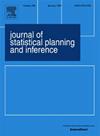Deterministic construction methods for asymmetrical uniform designs
IF 0.8
4区 数学
Q3 STATISTICS & PROBABILITY
引用次数: 0
Abstract
Asymmetrical (mixed-level) uniform designs are useful for both computer and physical experiments. However, constructing these designs is often challenging due to their complex asymmetrical structure. In this paper, we propose novel methods for constructing uniform designs with mixed two-, three-, and four/nine-levels. Our construction methods are deterministic, allowing us to circumvent the complexity associated with stochastic algorithms. We evaluate uniformity using the wrap-around - and Lee discrepancies. We establish useful analytic relationships between uniformity and aberration, and derive new general lower bounds for discrepancies that are tighter than those currently available in the literature. These new benchmarks can effectively measure the uniformity of asymmetrical designs. Additionally, we provide examples demonstrating the efficacy of our construction methods and the relevance of the newly obtained lower bounds. Finally, through simulations, we show that the designs produced using our methods perform well in constructing statistical surrogate models.
不对称均匀设计的确定性构造方法
不对称(混合水平)均匀设计对计算机和物理实验都很有用。然而,由于其复杂的不对称结构,构建这些设计通常具有挑战性。在本文中,我们提出了一种新的方法来构建混合二、三、四/九层的均匀设计。我们的构造方法是确定性的,允许我们规避与随机算法相关的复杂性。我们使用环绕L2-和Lee差异来评估均匀性。我们在均匀性和像差之间建立了有用的分析关系,并推导出比目前文献中可用的更严格的差异的新一般下界。这些新的基准可以有效地测量非对称设计的均匀性。此外,我们还提供了一些例子来证明我们的构造方法的有效性和新获得的下界的相关性。最后,通过仿真,我们表明使用我们的方法产生的设计在构建统计代理模型方面表现良好。
本文章由计算机程序翻译,如有差异,请以英文原文为准。
求助全文
约1分钟内获得全文
求助全文
来源期刊
CiteScore
2.10
自引率
11.10%
发文量
78
审稿时长
3-6 weeks
期刊介绍:
The Journal of Statistical Planning and Inference offers itself as a multifaceted and all-inclusive bridge between classical aspects of statistics and probability, and the emerging interdisciplinary aspects that have a potential of revolutionizing the subject. While we maintain our traditional strength in statistical inference, design, classical probability, and large sample methods, we also have a far more inclusive and broadened scope to keep up with the new problems that confront us as statisticians, mathematicians, and scientists.
We publish high quality articles in all branches of statistics, probability, discrete mathematics, machine learning, and bioinformatics. We also especially welcome well written and up to date review articles on fundamental themes of statistics, probability, machine learning, and general biostatistics. Thoughtful letters to the editors, interesting problems in need of a solution, and short notes carrying an element of elegance or beauty are equally welcome.

 求助内容:
求助内容: 应助结果提醒方式:
应助结果提醒方式:


